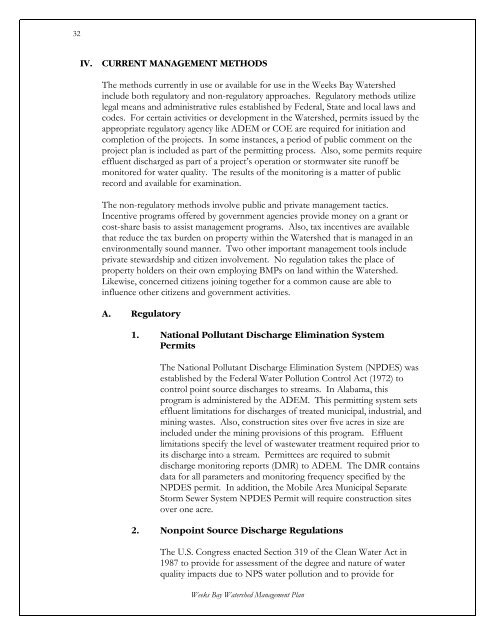Weeks Bay Watershed Project Management Plan - Mobile Bay ...
Weeks Bay Watershed Project Management Plan - Mobile Bay ...
Weeks Bay Watershed Project Management Plan - Mobile Bay ...
You also want an ePaper? Increase the reach of your titles
YUMPU automatically turns print PDFs into web optimized ePapers that Google loves.
32<br />
IV. CURRENT MANAGEMENT METHODS<br />
The methods currently in use or available for use in the <strong>Weeks</strong> <strong>Bay</strong> <strong>Watershed</strong><br />
include both regulatory and non-regulatory approaches. Regulatory methods utilize<br />
legal means and administrative rules established by Federal, State and local laws and<br />
codes. For certain activities or development in the <strong>Watershed</strong>, permits issued by the<br />
appropriate regulatory agency like ADEM or COE are required for initiation and<br />
completion of the projects. In some instances, a period of public comment on the<br />
project plan is included as part of the permitting process. Also, some permits require<br />
effluent discharged as part of a project’s operation or stormwater site runoff be<br />
monitored for water quality. The results of the monitoring is a matter of public<br />
record and available for examination.<br />
The non-regulatory methods involve public and private management tactics.<br />
Incentive programs offered by government agencies provide money on a grant or<br />
cost-share basis to assist management programs. Also, tax incentives are available<br />
that reduce the tax burden on property within the <strong>Watershed</strong> that is managed in an<br />
environmentally sound manner. Two other important management tools include<br />
private stewardship and citizen involvement. No regulation takes the place of<br />
property holders on their own employing BMPs on land within the <strong>Watershed</strong>.<br />
Likewise, concerned citizens joining together for a common cause are able to<br />
influence other citizens and government activities.<br />
A. Regulatory<br />
1. National Pollutant Discharge Elimination System<br />
Permits<br />
The National Pollutant Discharge Elimination System (NPDES) was<br />
established by the Federal Water Pollution Control Act (1972) to<br />
control point source discharges to streams. In Alabama, this<br />
program is administered by the ADEM. This permitting system sets<br />
effluent limitations for discharges of treated municipal, industrial, and<br />
mining wastes. Also, construction sites over five acres in size are<br />
included under the mining provisions of this program. Effluent<br />
limitations specify the level of wastewater treatment required prior to<br />
its discharge into a stream. Permittees are required to submit<br />
discharge monitoring reports (DMR) to ADEM. The DMR contains<br />
data for all parameters and monitoring frequency specified by the<br />
NPDES permit. In addition, the <strong>Mobile</strong> Area Municipal Separate<br />
Storm Sewer System NPDES Permit will require construction sites<br />
over one acre.<br />
2. Nonpoint Source Discharge Regulations<br />
The U.S. Congress enacted Section 319 of the Clean Water Act in<br />
1987 to provide for assessment of the degree and nature of water<br />
quality impacts due to NPS water pollution and to provide for<br />
<strong>Weeks</strong> <strong>Bay</strong> <strong>Watershed</strong> <strong>Management</strong> <strong>Plan</strong>
















